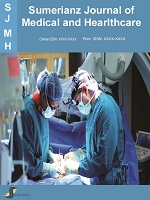Sumerianz Journal of Medical and Healthcare

Online ISSN: 2663-421X
Print ISSN: 2706-8404
Quarterly Published (4 Issues Per Year)
Journal Website: https://www.sumerianz.com/?ic=journal-home&journal=31Archive
Volume 2 Issue 7 (2019)
Influence of Risk Factors and Food Habits on Serum Levels of Vitamin D
Authors : Luís Henrique Cerqueira Vila Verde ; Adriano Piccolotto ; Adriane Yaeko Togashi
Abstract:Vitamin D (VD) plays an important role in the formation, development, maintenance and repair of bone tissue. Due to the physiological importance of VD, this study aimed to observe the rate of hypovitaminosis D (hD) in a population and the factors that may influence the incidence of hD. All participants of the groups were submitted to a Semi-Quantitative Food Frequency Questionnaire (SQFFQ) on the intake of dietary calcium, in order to assess the risk factors. The patients were submitted to laboratory examinations of serum 25-hydroxyvitamin D; those who presented serum VD levels below 30 ng/mL were allocated to the abnormal group (insufficient or deficient) and participants with levels equal to or above 30 ng/mL were allocated to the normal group (sufficient). Patients who were allocated to the abnormal group were submitted to VD supplementation. 35% of subjects in the study population presented hD. Regarding the food questionnaire, a lower amount of milk-derived intake, such as yogurt, and a lower frequency of physical activities presented a higher risk for hD development. One can conclude that less than half of the sample had hD and calcium-rich foods may contribute to normal serum levels of VD.
Evaluation of Acute Oral Toxicity Induced By N-Hexane Extract of Leptadenia Hastata Leaves on the Histology of the Pancreas and Spleen in Albino Rats
Authors : Attah M. O. O. ; Jacks T. W. ; Garba S. H. ; Anagor K.
Abstract:Introduction: This study was undertaken to investigate the toxicological profile of the n-hexane extract of Leptadenia hastata after acute administration on the histology of the pancreas and spleen of albino rats. Methodology: A total of seventeen (17) albino rats were used for the study. For the acute toxicity study, Lorke’s method was adopted. Twelve rats were grouped into two groups comprising of six rats each, which received a dosage of 10mg/kg, 100mg/kg and 1000mg/kg in the first phase. The second phase consisted of three groups of two rats each being administered a dosage of 1600mg/kg, 2900mg/kg and 5000mg/kg. Five rats were given 1000mg/kg, 2000mg/kg, 3000mg/kg, 4000mg/kg and 5000mg/kg of n-hexane extract of Leptadenia hastata to determine the effect of the extract on the pancreas and spleen at these concentrations. The rats were observed for general behavioral changes, adverse effects and mortality up to 7 days post-treatment. Body weight, food intake and water intake were monitored throughout the experimental period and the pancreas and spleen were removed and evaluated at the end of the experiment. Results: In the acute toxicity study, there was no any mortality or significant behavioural changes observed after administering the highest dose (5000mg/kg). Histological analysis showed normal histological appearance in the pancreatic and splenic tissue at a dosage below 2000mg/kg but tissue heamolysis at a concentration greater than 3000mg/kg. Conclusion: These results demonstrate that the extract may not have any single dose toxicity. The LD50 value is greater than 5000 mg/kg. However, at tissue level, there was observable heamolysis at a concentration above 3000mg/kg.
Prevalence, And Outcome of Management of Major Depressive Disorder Among Patients in Federal Neuro-Psychiatric Hospital, Calabar, Cross River State, From January, 2012to December, 2014
Authors : Oyira Emilia James ; Agba M.
Abstract:This study examined the prevalence, and outcome of management of major depressive disorder among patients in Federal Neuro-Psychiatric Hospital, Calabar, Cross River State, from January, 2012to December, 2014. Four specific objectives were stated to determine the frequency of occurrence, medical and nursing management and outcomes of MDDs. 130 MDD patients (34 males and 96 females) admitted in the study area from January, 2012 to December, 2014 were used for the study. A checklist was developed and used to review the patients’ records/folders. Data collected through the checklist were analyzed on frequency tables and presented in pie charts. They were interpreted using simple percentage analysis. The result showed that the rate of occurrence of major depressive disorder in Federal Neuro-Psychiatric Hospital, Calabar, from January 2012 to December 2014 was low, with a ratio of 1:11; anti-depressants (100.00%), anti-psychotics (78.40%), mood stabilizers (46.10%) and anti- anxiety (46.10%) drugs were the major pharmacotherapy used in the management of clients with major depressive disorder in Federal Neuro-Psychiatric Hospital, Calabar, with anti-depressants such as selective serotonin reuptake inhibitors (SSRI) and aminomine oxidaze inhibitors (AMOIs), and typical and atypical anti-psychotics such as chlorpromazine, stelezine and clozepine olonzepine mostly in use as combined therapy and non-received only anti-depressants; while majority of the patients were managed using cognitive behavioural therapy, behavioural therapy and family therapy; but ECT was not widely used. The nursing management strategies mostly in use in the Hospital were: assessment and assistant with psychological need, close observation/monitoring, one-on-one psycho-education, medication education and nurses’ review. Majority 81(62.31%) of the MDD patients had a good outcome (GO) after treatment. It was recommended that the management of MDD should include other forms of management strategies utilized in other establishments around the globe like combination of pamphlet, telephone psycho-education and calls to patients to remind them of medication time and keeping to appointment, further studies that will adopt the patient follow-up approach to determine patients rate of responding to treatment, patients satisfaction with care and care givers satisfaction were recommended since this present study was mainly a retrospective study, based on review of patients’ folders and hospital records.



